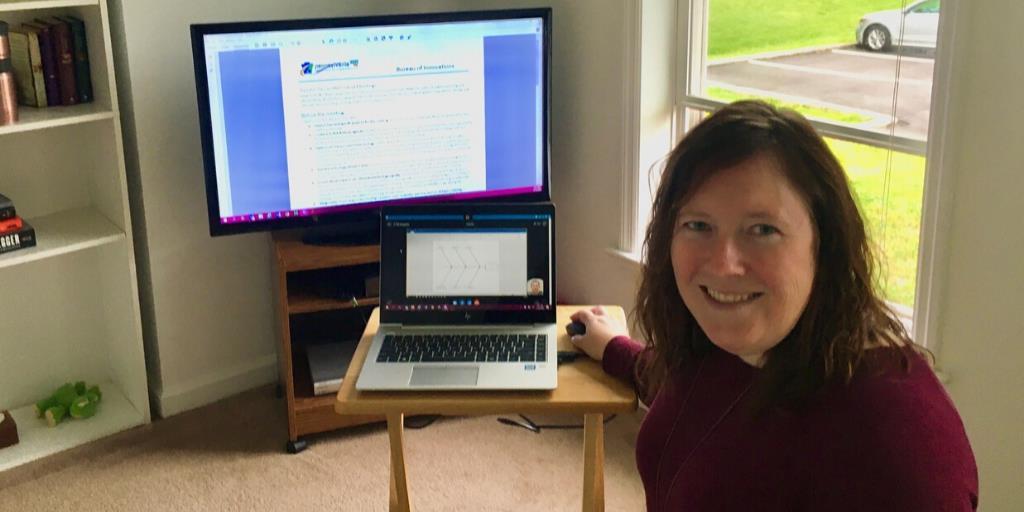
With the onset of the COVID-19 pandemic and commonwealth agencies moving many employees to telework status, PennDOT's Bureau of Innovations (BOI) quickly adapted to continue providing meaningful facilitations for department organizations now in a virtual environment.
No stranger to helping other PennDOT organizations evaluate processes and make recommendations for change, BOI found itself looking inward to identify how it could transition its typical in-person facilitations to ones that would be equally successful online.
“When we started teleworking, I thought how can we do everything we do in person in a virtual environment," said Amanda Frank, a management analyst 2 in the bureau. “How do we make the most of this and find opportunities to improve upon what we already do and broaden our bureau's various services offerings."
With BOI conducting dozens of facilitations each year, and in the spirit of innovation, team members put their heads together to find ways BOI could serve the department and successfully run virtual facilitations.
“We realized very quickly that an online facilitation would not look the same as an in-person facilitation," said Frank. “Parts would have to run differently, there would be hiccups, and we needed to be okay with that."
BOI ran a trial facilitation with some of its team members serving as facilitators, while other served as participants. The practice run allowed the team to push the boundaries of what could be done in an online format and maximize the tools available.
“It allowed us to test Skype and its limitations and identify how to get the most out of it to run a successful facilitation," said Frank. “The trial run also allowed us to identify the BOI resources that would be required to run a successful virtual facilitation. We were able to determine how many people we need and what roles they would serve during the facilitation."
Gleaning best practices from the trial run and facilitations it has conducted thus far, BOI developed a virtual facilitation guide that not only shares essential tips for successfully conducting a virtual meeting but provides guidance to those participating in the meeting as well.
“Using this guidance, we've been able to facilitate in a virtual environment something that is close to what we are able to facilitate in an in-person meeting," said Frank. “That surpassed what my expectation was when we started teleworking. It's been a happy surprise and has changed our bureau's perception of what we can do in this environment."
While BOI has adapted quickly, the move to virtual facilitations has proven challenging in some respects. “When you are facilitating online, you are missing the non-verbal cues that you would normally get during an in-person setting," said Frank. “If someone wants to interject and say something, you don't have the opportunity to read that in their body language, so it's more difficult to facilitate group discussions in a virtual environment. You have to get creative and change up your approach."
To interact with participants and keep them engaged during online facilitations, BOI is using the polling feature in Skype. “During in-person facilitations, we've typically used sticker dots or texting software to allow participants to vote and gain consensus," said Frank. “The polling feature in Skype provides that same functionality and has proven beneficial to keeping participants involved."
Through their experiences, BOI team members have found that it's important to have a good idea of what you want to accomplish during the virtual facilitation, and more importantly, how you want participants to interact, including using the chat feature, polling, round robin approach, or other similar facilitation tactics.
“The round robin approach has been successful for us, asking each participant at various points throughout the meeting if they have anything to add to the discussion," said Frank. “Regardless of the approach used, the most important thing is to have a game plan and set clear expectations for your meeting participants."
ABOUT THIS BLOG
Did you know PennDOT is directly responsible for nearly 40,000 miles of highway and roughly 25,000 bridges? We oversee programs and policies affecting highways, urban and rural public transportation, airports, railroads, ports and waterways, in addition to administering the state's more than 11 million vehicle registrations and 8.8 million driver's licenses.
So, how do we do what we do? And how can we help you travel in Pennsylvania — whether it be for business or leisure — in safe and enjoyable manner? Read PennDOT Way to learn more about the department, what we do, and how and why we do it.
TAGS
50-Year Anniversary, 511PA, Aggressive Driving, Airports, Autonomous Vehicles, Bicycles, Bridges, Child Safety, Community Relations, Construction, COVID-19, Distracted Driving, District 1, District 10, District 11, District 12, District 2, District 3, District 4, District 5, District 6, District 8, District 9, DOTcom, Driver and Vehicle Services, Emergency Responders, Employment, Equity, FAQ Friday, Human Trafficking, Impaired Driving, Innovations, Live Free Ride Alive, Maintenance Monday, Motorcycles, Older Drivers, PA Motorcycle Safety Program, Pedestrians, PennDOT Connects, Ports, Public Transit, Railroads, REAL ID, Road MaP, Roadside Beautification, Rural Roads, Safety, School Buses, Seat Belts, State Transportation Innovation Council (STIC), Sustainability, Teen Drivers, Throwback Thursday, Transportation Funding, Travel in PA, Welcome Centers, Winter, Work Smart, Work Zone, Yellow Dot
LATEST POSTS
PennDOT Continues Sharing, Updating Resources for Local Governments to Pursue Bipartisan Infrastructure Law Funding Opportunities
Norwin High School Wins 2024 ‘Innovations Challenge’
Demo Complete: I-95 CAP Project in Center City Philadelphia
PennDOT Archeologist Connects Past, Present, and Future
Lehigh Valley DUI, Highway Safety Task Force Hosts Law Enforcement Seminar
ARCHIVES
2024
2023
2022
2021
2020
2019
2018
2017

